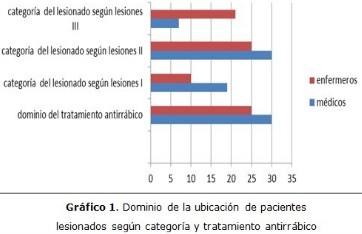Theoretical foundations of the doctors and nurses´ performance in the management of Rabies
Keywords:
DeCS, análisis y desempeño de tareas, rabia, educación médica.Abstract
Background: in the report of 2016, the World Health Organization (WHO) reported that 55 000 people died of rabies in Africa and Asia and the vaccine is not the best way to prevent the illness because of the high cost, in this analysis carried out by the WHO, declares 95 % of patients are younger than 15 years old.
Objective: to describe the systematization the theoretical foundations that support the preparation for exert of doctor and nurse of family in the management of the Rabies.
Methods: it was conducted a descriptive study in the period 2012-2017, the investigation is supported from the dialectic-materialist conception, for the obtaining of data and the processing the information was employed as theoretical methods (documentary analysis, systematization and historical-logical), doctors and nurses of family in the municipality Boyeros.
Results: the carried out systematization allowed to find regularities that turn into antecedents for operative definition that proposes on exert of the doctor and nurse of family in the management of rabies from foundations of the medical education as educational theory.
Conclusions: the carried out systematization on the improvement of the exert of the doctor and nurse of family, allowed to establish an approach centered in theoretical referents that support the improvement of exert of the doctor and nurse of family, identifying the principles of education in the work for the exert of these personnel in the management of rabies.
DeCS: EMPLOYEE PERFORMANCE APPRAISAL; TASK PERFORMANCE AND ANALYSIS; RABIES; EDUCATION, MEDICAL; DISEASE MANAGEMENT.
Downloads
References
1.- Pelayo Ulacia S. Enfermedades virales. En: Pelayo Ulacia S. Zooantroponosis. La Habana: Editorial Ciencias Médicas; 2008. p. 194-205.
2.- Tordo N. Characteristics and molecular biology of the rabies virus. En: Meslin FX, Kaplan MM, Koprowski H. Laboratory techniques in rabies 4 edition, Word Health Organization, Geneva, 1996
3. - Jackson AC. Recovery from rabies: A call to arms. Journal of the Neurological Sciences. [revista en la Internet]. 2014, [citado 2018 ene 11]: 5-7. Disponible en: http// www.elsevier.com/locate/jns
4.- Qu Z-Y, Li G-W, Chen Q-G, Jiang P, Liu C, Lam A. Survival of a newborn from a pregnant woman with rabies infection. Journal of Venomous Animals and Toxins including Tropical Diseases. 2016;22(1):14. DOI 10.1186/s40409-016-0068-5
5.- Weyer J, Msimang-Dermaux V, Paweska JT, le Roux K, Govender P, Coertse J, et al. A case of human survival of rabies, South Africa. Southern African Journal of Infectious Diseases. 2016 [citado 2017 Nov 23];31(2):66-8. Disponible en: https://doi.org/10.1080/23120053.2016.1128151
6.- Costa MV. Información Veterinaria, CMVPC, Córdoba. 2013; 173:28-30
7. - Kotait I, Carrieri ML, Takaoka NY. Raiva: Aspectos gerais e clínica. Manual Técnico do Instituto Pasteur . 2009;8:1-49
8.- Infovet. Casos clínicos de rabia terrestre en la Cuidad de Buenos aires. 2008, Disponible en: http://www.fvet.uba.ar.
9.- Galán Torres JA. La rabia: perspectiva actual. Sanid. Mil. [revista en la Internet]. 2012 Dic [citado 2015 Feb 02]; 68(4): 201-202. Disponible en: http://scielo.isciii.es/scielo.php?script=sci_arttext&pid=S1887-85712012000400001&lng=es
10.- Rojas Ochoa F. Vacunas. Cuba 1995-208. En: Delgado García G. La vacunación en Cuba 1884-1958. La Habana. Editorial. Ciencias Médicas, 2011.Pág 51-2.
11.- García Castellanos TC. Modelo de Evaluación de Impacto de la especialidad en Enfermería Comunitaria. [Tesis] Doctor en Ciencias Pedagógicas La Habana, 2016
12.- Perdomo Cáceres AB. Programa de mejoramiento permanente del desempeño profesional del enfermero técnico en la educación para la salud. [Tesis]Doctor en Ciencias Pedagógicas, 2015.
13.- Añorga Morales JA, Dora L, Magaz DE, Caballero Báez JA, De Toro J. Glosario de términos de Educación Avanzada. La Habana: CENESEDA. Instituto Superior Pedagógico Enrique José Varona, 1994.
14.- Caballero Báez JA. Estrategia de profesionalización para el desarrollo de la competencia producción intelectual en el docente de enfermería [Tesis] de Doctor en Ciencias Pedagógicas. La Habana, 2015.
15.- Martínez Ortiz LA. Estrategia Educativa para el desarrollo de la Medicina Natural y Tradicional en la atención secundaria de salud. [Tesis] de Doctor en Ciencias Pedagógicas, 2014.
16.- Pichs García LM. Estrategia Pedagógica Interventiva para la formación en urgencias médicas del médico general. Tesis en opción al grado de Doctor en Ciencias Pedagógicas. 2014.
17.- Sierra Pérez D, Muñiz Roque AM, Gandul Salabarría L, Pérez Charbonier C, Barceló Montiel Z, Fernández Corona BG, et. al. Programa del médico y enfermera de la familia. La Habana: Editorial Ciencias Médicas. 2011.

Published
How to Cite
Issue
Section
License
Copyright: Camagüey Medical Archive Magazine, offers immediately after being indexed in the SciELO Project; Open access to the full text of the articles under the principle of making available and free the research to promote the exchange of global knowledge and contribute to a greater extension, publication, evaluation and extensive use of the articles that can be used without purpose As long as reference is made to the primary source.
Conflicts of interest: authors must declare in a mandatory manner the presence or not of conflicts of interest in relation to the investigation presented.
(Download Statement of potential conflicts of interest)
The Revista Archivo Médico de Camagüey is under a License Creative Commons Attribution-Noncommercial-No Derivative Works 4.0 International (CC BY 4.0).
This license allows others to distribute, to mix, to adjust and to build from its work, even for commercial purposes, as long as it is recognized the authorship of the original creation. This is the most helpful license offered. Recommended for maximum dissemination and use of licensed materials. The full license can be found at: https://creativecommons.org/licenses/












 22 julio 2025
22 julio 2025